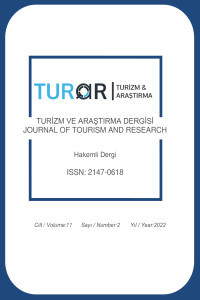SPECIFYING THE RELATIONSHIP AMONG PERCEIVED SERVICE QUALITY, CUSTOMER LOYALTY AND CUSTOMER VALUE oF THE HALAL HOTELS IN HIGH SEASON
SPECIFYING THE RELATIONSHIP AMONG PERCEIVED SERVICE QUALITY, CUSTOMER LOYALTY AND CUSTOMER VALUE oF THE HALAL HOTELS IN HIGH SEASON
The importance of Halal products and services increases day by day with the developments in world economy and affects the whole products and services; this movement is effective on tourism sector, too. Today, hotels try to develop Halal services’ process alongside their current services, to meet their customers’ needs who demand Halal products and services to create customer loyalty. In this study, it is tried to figure out the relationship among perceived service quality, customer loyalty and customer value of the Halal hotels in high season. For finding out this relationship a survey is conducted to Halal hotel customers
Keywords:
Halal Hotels, Customer Loyalty Customer Value, Service Quality,
___
- Barutçu, S. (2007). GSM Sektöründe Müşteri Bağlılığı: PAmukkala Üniversite Öğrencilerinin GSM Operatörlerine Bağlılıkları ve Bağlılıklarını Etklieyen Faktörler. Afyon Kocatepe Üniversitesi İktisadi ve İdari Bilimler Fakültesi Dergisi, 9(1), s. 352–.
- Bülbül, H., & Demirer, Ö. (2008). Hizmet Kalitesi Ölçüm Modelleri SERVQUAL ve SERPERF'in Karşılaştırmalı Analizi. Selçuk Üniversitesi Sosyal Bilimler Enstitüsü Dergisi, 20, s. 181– 198.
- Çatı, K., Murat, C., & Gelibolu, L. (2010). Müşteri Beklentileri ile Müşteri Sadakati Arasındaki İlişki: Beş Yıldızlı Bir Otel Örneği. Ç.Ü. Sosyal Bilimler Enstitüsü Dergisi, 1, s. 429–446.
- Helkkula, A., & Pihlström, M. (2003). From Customer Perceived Value (PERVAL) to Value in Context Experience (VALCONEX). U.K.: Hanken School of Economics.
- Karasar, N. (2009). Bilimsel Araştırma Yöntemi. Ankara: Nobel Yayınları.
- Koç, Ü. (2007). Hizmet Kalitesi Algılamalarının Müşteri Bağlılığına Etkisi ve Bir Uygulama. Kocaeli: Kocaeli Üniversitesi Sosyal Bilimler Enstitüsü.
- Liu, C., Marchewka, J., Lu, J., & Yu, C. (2005). Beyond Concern: A Privacy–Turst–Behavioral Intention Model of Electronic Commerce. Information and Management, 42(3), s. 289–304.
- Narayandas, N. (1996). The Link Between Customer Satisfaction and Customer Loyalty: An Empricial Investigation Working Paper. Harvard Business Schooll(No:97–107).
- Onaran, B., Bulut, Z., & Özmen, A. (2013). Müşteri Değerinin, Müşteri Tatmini, Marka Sadakati ve Müşteri İlişkileri Yönetimi Performansı Üzerindeki Etkilerinin İncelenmesine Yönelik Bir Araştırma. Business and Economic Research Journal, 4(2), s. 37–53.
- Parasuraman, A., Zeithaml, V., & Berry, L. (1985, Fall). A Conceptual Model of Service Quality and Its Implications for Future Research. Journal of Marketing, 49, s. 41–50.
- Parasuraman, A., Zeithaml, V., & Berry, L. (1988). SERVQUAL: A Multiple–Item Scale for Measuring Consumer Perceptions of Service Quality. Journal of Retailing, 1, s. 12–40.
- R., F.–S., & M.A., B.–I. (2007). The concept of perceived value: a systematic review of the research. Pennsylvania.
- Rai, A., & Medha, S. (2013). The Antecedents of Customer Loyalty: An Empricial Investigation in Life Insurance Context. Journal of Competitiveness, 5(2), s. 139–163.
- Sümbüloğlu, V., & Sümbüloğlu, K. (2000). Sağlık Bilimlerinde Araştırma Yöntemleri. Ankara: Hatipoğlu Yayınları.
- Sweeney, J., & Soutar, G. (2001). Customer Perceived Value: The Developement of a Multiple Item Scale. Journal of Retailing, 77(2), s. 203–220.
- Wang, Y., Lo, H., Chir, R., & Yang, Y. (2004). An Integrated Framework for Customer Value and Customer Relationship Management Performance: A Customer Based Perspective From China. Managing Service Quality, 14(2–3), s. 169–182.
- Zeithaml, V., & Bitner, M. (2003). Services Marketing, Integrating Customer Focus Across the Firm. New–York: McGraw–Hill Higher Education.
- ISSN: 2147-0618
- Yayın Aralığı: Yılda 2 Sayı
- Başlangıç: 2012
- Yayıncı: Toleyis Sendikası
